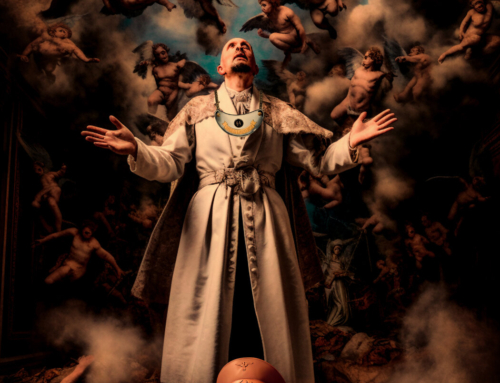This is an excerpt from my book The Mystery of the Magi.
The wonderful Star of Bethlehem is one of the most enduring and endearing parts of the Christmas magi story. Carols and cards and Christmas storybooks all promote the magical mystery star that moved through the night sky, leading the wise men on an arduous journey across the desert to the humble birthplace of Jesus Christ. The enchantment of the story remains, but astronomers are quick to point out that stars don’t do that. Stars are fixed points. They don’t move across the sky from one place to another.
Of all the aspects of the magi story, the star has fascinated people most. Books speculating about the star of Bethlehem fill library shelves, but as I researched the story of the magi it became clear that investigation of this ancient story should not begin with the star, but with the magi themselves. If we know the identity of the wise men, the origin and importance of the star falls into place.
A Supernatural Miracle Star?
Bradley Schaefer, professor of physics and astronomy at Louisiana State University has studied the Star of Bethlehem and outlines four possibilities in the attempt to identify the star. “All of the attempted explanations can be categorized as one of the following: a pious fable, an astronomical event, a miracle or an astrological horoscope.”
If the star was part of a pious fairy tale we wouldn’t be this far along in this book. Like most academics we would have come to that conclusion and moved on. The second theory is that the star was a divine celestial portent— a miracle provided by God himself.
The idea that the star was a supernatural portent that moved across the night sky began with the gnostic myths that were concocted about the magi. In the Syrian Infancy Gospel the star is an angel who appears and leads the wise men to Jesus. In the ludicrously fanciful Legend of Aphroditianus a star appears in a pagan temple where the statues have come alive and are dancing. The star then leads the magi across the desert on their mystical quest. Similarly in The Revelation of the Magi the star appears as a blazing baby in the sky who tells the wise men to go on the journey, and then guides them by floating before them in the night sky and performing miracles along the way.
The prevalence of such ridiculous gnostic myths contributed to the assumption that the star was a magical astronomical phenomenon. Because most believers down the ages took for granted the miraculous nature of the star, critical scholars have dismissed the story story as a pious fiction.
Their scorn for the story is understandable. It seems too much like the blue fairy singing “When You Wish Upon a Star” in Disney’s Pinocchio. The fact that magical stars are the stuff of fairy tales, and that the Christmas star continues to be romanticized with ever more lovely stories like the Little Drummer Boy does not encourage academics to take it seriously.
When You Wish Upon a Star
How did Matthew understand the star sign? It is possible that he believed that it was a miraculous gift from God. Furthermore, we should not necessarily rule out a supernatural solution. It could be that God produced a miraculous star that moved across the night sky and led the wise men to the Christ child.
Questions arise. If there was a supernaturally mobile star that guided the wise men why didn’t it take them directly to Bethlehem instead of leading them first to Jerusalem? If the star was a visible manifestation of a supernatural intervention why didn’t everyone see it? Indeed, why isn’t such a stupendous phenomenon recorded in the annals of ancient stargazers? We have astronomical records from China and elsewhere in the ancient world. Why no mention of the amazing moving star from around 6 BC?
It could be that the star was like apparitions to mystics in which they are the only ones who see the sun spin or who witness an appearance of the Virgin Mary or an angel. Matthew’s account doesn’t sound like that however. It is more matter of fact. Nevertheless, while we do not rule out the possibility of a miracle, we also believe in common sense. We are right to be skeptical of the supernatural solutions.
Most importantly, a supernatural star that guided the wise men across the desert is not actually what Matthew records. He mentions the star twice. First the wise men say to Herod, ““Where is the one who has been born king of the Jews? We saw his star when it rose and have come to worship him.” Then in verse nine he writes, “After they had heard the king, they went on their way, and the star they had seen when it rose went ahead of them until it stopped over the place where the child was.”
Before their journey they saw a star “when it rose” then the star appeared to direct them to Bethlehem where it stopped. As we will see, there are other explanations that make better sense and are more faithful to Matthew’s text.
While we allow for the star to be a miracle directly provided by the Almighty, it seems improbable. We should only come to the supernatural conclusion once we have ruled out all the natural possibilities. Therefore the next possibility is that the star of Bethlehem was a natural, historical, observable celestial phenomenon.
A Natural Astronomical Event?
This is where the astronomers become interested and excited, and this is where the scriptwriters for Christmas planetarium shows come into their own. This theory is that a comet, supernova or conjunction of planets produced a spectacular display that convinced the wise men to go on a search for the infant King of the Jews.
Astronomers using up to date computer technology that allows them to see the night sky at any place and in any date in history, have pored over the charts to find suitably spectacular stellar events.
Bradley Schaefer publishes a list of over a dozen such events in the decade of Christ’s birth. The problem with this astronomical theory, is that “all decades are crowded with spectacular astronomical events.” This has not stopped astronomers from proposing their theories. So, for example, Kepler proposed that the star was a triple conjunction that spawned a supernova while astro-archeologist Mark Kidger suggests that the Star of Bethlehem was a recurrent nova which appeared in 5 BC and was recorded by Chinese stargazers.
There are actually umpteen different theories about astral events, and astronomers debate this evidence back and forth. The main problem with the astronomical theory (like the supernatural theory), are some common sense objections. Firstly, if there are so many “spectacular astronomical events” are they really so spectacular? While the various novas, supernovas, comets and planetary conjunctions might have been impressive were they really so unusual? If the spectacular astral event was so amazing why didn’t everyone see it, and why was it not recorded by the ancient historians?
More problematic, why would an ancient stargazer in Persia or India see a supernova or a comet and assume that a new King was to be born to an obscure Judean race, and that this event was of cosmic importance?
Most telling is the question why an unusual astronomical event should prompt a religious quest. Why would an ancient stargazer see a startling phenomenon in the night sky and draw the conclusion that he should load up his camels, travel to Jerusalem and start searching for a Jewish messiah? The simple occurrence of an unusual stellar display does not, on its own, demand the journey to Jerusalem. If there was a spectacular astral event there must have been some other factor which motivated the observers to connect that event with the birth of Jewish royalty.
With three of the four solutions seeming improbable, we are left with the astrological answer. According to this theory, the star was not primarily a spectacular astronomical display, but an alignment of the planets which was interpreted by astrologers as a prediction that a child was about to be born who would rule over the Jewish people.
The astrological solution solves two recurring problems. Firstly, it answers the difficulty of the star not being seen by most people. According to the astrological theory, the “star” was not a magical moving astronomical phenomenon, nor was it a spectacular astral display. Instead it was an unusual configuration of planets and constellations whose significance would only have been observed and understood by those adept in astrology.
Secondly, the whole point of astrology is to read the movements of the planets and predict events on earth. There is no motivation for someone who simply observes an unusual astral display to journey to Jerusalem. However, an astrologer—who is constantly reading the constellations for deeper significance— may have not only seen in the stars the birth of a Jewish king, but (given his circumstances) may have been highly motivated to set out to find that prince and pay him homage.
Molnar’s Theory
Michael Molnar’s 1999 book, The Star of Bethlehem: The Legacy of the Magi was the first scholarly treatment outlining the astrological theory. Molnar had been studying ancient astrological texts for years before he deduced that the Star of Bethlehem was actually an astrological rather than an astronomical phenomenon.
The first thing to grasp about Molnar’s theory is that the “star” was not what we understand as a star. It was a planet. The language of the Bible does not distinguish stars from planets as we do. Therefore when Matthew quotes the wise men, “We have seen his star rising” they were referring to a planet not a star.
Astrologers monitor the movement of the planets believing that, by doing so, they are able to predict events on earth. Molnar explains how ancient astrologers’ primary tool was the zodiac. The zodiac is a chart of the constellations which helps to analyze the movement of the planets at a particular time and place and deduce the significance.
Using the zodiac, a horoscope can be drawn up. A horoscope is a chart of the locations of the sun, moon and planets at a particular point in time. A natal horoscope is a report from the date of a child’s birth, and (according to the theory) it helps to explain the personality and destiny of the child. By understanding the regular movement of the planets, the astrologer also believes it is possible to predict what might happen in the future.
The study of astrology is extremely arcane, and demands a thorough knowledge of astronomy as well as astrological theory. Attempting to understand the intricacies of ancient astrology demands even more expertise. Retired astronomer Molnar is one of the experts, and he lays out a strong case that the magi astrologers observed certain signs in the heavens which convinced them of the imminent birth of a newborn king of the Jews.
Jupiter Rising in Aries
I will attempt to summarize Molnar’s theory briefly: In the ancient middle East astrologers assigned different countries to the different star constellations. So, for example, Taurus the Bull might be assigned to Babylon, while Italy was associated with Leo the Lion and Persia with Virgo the Virgin. Although theories vary, Molnar believes the astrologers at the time of Christ associated Judea with the constellation Aries the Ram.
The planets associated with royalty were Jupiter and the moon. On ancient coins and inscriptions a blazing star (which is the sign for a planet) and a crescent moon indicate royalty. Molnar therefore looked for an unusual conjunction of the moon and Jupiter in the constellation Aries within the appropriate time span of when Jesus’ birth could have happened. Tracking back through history, Molnar found a very unusual event on April 17, 6 BC.
Jupiter was rising in the constellation Aries, but with a “lunar occultation,” In other words, the planet was hidden by (or very close to) the moon. Astrologers believed that the moon strengthened the royal importance of the presence of Jupiter. Furthermore, while this was occurring, Jupiter was present in a “heliacal rising”. This means the planet was appearing on the horizon at the same time, or just before the sun. On that date the royal planet Jupiter was rising with the sun and was embraced by the moon. This is very unusual, and according to astrological theory, indicates an amazingly powerful royal presence. That this took place in the constellation Aries revealed to the astrologers that a great king would be born in Judea.
Molnar believes two of the phrases in Matthew’s account actually indicate knowledge of these astrological principles. The New International Version of the Bible translates verse two of Matthew’s account as, “Where is the one who has been born king of the Jews? We saw his star when it rose and have come to worship him.” Remembering that “star” just as easily means “planet”, Molnar theorizes that the phrase “We saw his star when it rose” means the wise men witnessed the all important heliacal rising of Jupiter on April 17, 6 BC.
Molnar’s theory also explains the curious detail in Matthew’s account that the star they had seen “went before them and stopped where the child was.” Astronomers point out that planets on the move don’t stop over a specific location. However, Molnar believes Mathew’s description refers to an astronomical phenomenon known as “planetary retrograde motion and stationing.” “As the earth moves in its orbit it speeds past Jupiter and produces the illusion that Jupiter halts and reverses its motion against the background of stars.”
The Magi were already on their way to Bethlehem, having been sent there by Herod. As they travelled the few miles South, Jupiter appeared to reverse its progress across the sky and stop just as they reached Bethlehem. According to Ptolemy—one of the most important astrologers of antiquity—the retrograde motion and stationing also strengthens the predicted earthly phenomenon: “Planets when they are heliacal rising or stationary, produce intensification of the events.” Knowing this, the astrologer Magi were, as Matthew records, overjoyed.
Larson’s Star of Bethlehem
Rick Larson is an amateur Bible scholar who also believes he has found an astrological solution to the mysterious star of Bethlehem. Using computer technology to study the night sky two thousand years ago, Larson agrees with Molnar that the Star of Bethlehem was actually the planet Jupiter.
In a documentary film called, The Star of Bethlehem, Larson lays out his findings. He suggests that a conjunction of Venus and Jupiter in the constellation Leo in 2-3 BC is the “star” the wise men saw. The fact that Jupiter is moving around the star “king star” Regulus is also thought to be significant.
Like Molnar, Larson suggests that the report of the star moving to Bethlehem and stopping over the scene of Christ’s nativity can be attributed to the “retrograde and stopping” appearance of a planet.
However, physicist and astronomer Aaron Adair has problems with Larson’s theory. He points out that Larson’s star observations are from 2 – 3 BC. However, Jesus was born during the reign of Herod the Great and he died in 4 BC. Furthermore, Larson’s assumption that the constellation Leo is associated with the Jews has no historical evidence. Ancient astrologers did assign geographical and national significance to certain star signs, but none of them assigned Leo to Judea or the Jews.
While Larson’s theory has been de-bunked, Molnar’s theory has also been criticized by fellow scholars. Meanwhile, archeo astronomer Mark Kidger offers what might be the best solution. He proposes that the wise men were influenced by several celestial events around 6 BC. Along with astrologically significant planetary conjunctions in the constellation Aries, Kidger notes conjunctions of Jupiter and Saturn in Pisces — a constellation also associated with the Jews. These conjunctions were spread over seven months in the year 7 BC. Kidger also suggests that the magi’s prognostications were confirmed by sighting a startling supernova which was recorded by Chinese astronomers in the year 5 BC.
While none of their theories are absolutely watertight, at very least Molnar, Larson and Kidger make a convincing case that the Star of Bethlehem was not a pious fable, nor was it a miraculous mystery star, nor was it a natural astral event. Instead the “star” was a configuration of constellations and planets that was interpreted by the astrologers as a sign that a new Judean prince had been born.







Thank you for a very good explanation. Have blessed Christmas.
Even given that the “star” was an astronomical event (possibly) and/or an astrological interpretation (probably), the fact of its timing and location in conjunction with the birth of Christ was, in fact, miraculous.
Much of that depends on what you mean by “miraculous”!
What I mean by miraculous is that it was not coincidental, but a remarkable divine verification of the identity of Jesus intended to enlighten the minds of those who are open to believe, like the events that John in his gospel refers to as signs.